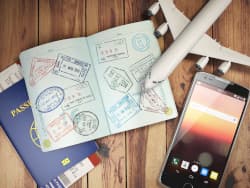
Sprawling over an enormous area and notorious for its traffic woes, Los Angeles can be a daunting place to navigate. But if you learn to be savvy about when and how you travel, you can avoid the worst of LA's transportation issues. From car rentals to taxis, ride-sharing, and public transit, here's everything you need to know about how to get around the city.
Public transport options in Los Angeles
Though LA is portrayed as a city of freeways, it does have some excellent public transport options – although the usefulness of these services really depends on where you live as some areas are not connected. However, if you do live on a good train or bus line, this is an excellent and very affordable way to get around. LA Metro is responsible for public transport and it's a good idea to download the Go Metro Los Angeles mobile app to help you get around the city. Across all services, transit rates start at $1.75. In addition to a single-ride fare, options include the Metro Day Pass ($7) and the 7-Day Pass ($25). We recommend getting a TAP card, which makes public transport easy and seamless to use.
Metro Rail
Metro Rail is a light rail and subway system operated by the Los Angeles County Metropolitan Transportation Authority also known as LA Metro. It includes several lines that connect various parts of the city.
Best areas: Metro Rail is ideal for getting around central LA, downtown, Hollywood, and areas near the rail lines. Popular lines include the Red Line (North Hollywood to Union Station), Blue Line (Downtown LA to Long Beach), and Expo Line (Downtown LA to Santa Monica). Fares start at $1.75 for a one-way trip, including transfers to other Metro Rail lines and buses. Various passes are available for regular commuters, tourists, and students. Discounts are offered for seniors and people with disabilities.Metro Bus
LA Metro operates an extensive network of bus routes covering the entire city. Buses are a convenient way to reach areas not served by Metro Rail. Metro buses are suitable for travelling to neighbourhoods and destinations not directly accessible by rail. Again, bus fares start at $1.75 for a one-way trip, which includes transfers to other Metro buses and rail lines. Passes and discounts are available, making bus travel a very affordable option for regular commuters.
Commuter Express and Metro Express buses
Commuter Express and Metro Express buses offer limited-stop service, providing quicker connections to key destinations, primarily during peak hours. These buses are designed for daily commuters travelling between the suburbs and downtown LA. They serve areas like San Fernando Valley, South Bay, and more. Fares vary by route, distance, and whether you use a TAP card or cash. Monthly passes and discounts are available for regular riders.
DASH buses
DASH (Downtown Area Short Hop) buses are a network of short, frequent shuttle routes that primarily serve downtown LA and adjacent neighbourhoods and are ideal for exploring downtown LA's attractions, including museums, parks, and cultural sites. Fares are typically $0.50 per ride, and TAP cards can be used for payment.
Metrolink (regional rail)
Metrolink is a regional commuter rail system that connects Los Angeles to surrounding counties, including Orange County, Riverside County, and Ventura County. In general, Metrolink is suitable for commuters travelling longer distances between LA and nearby counties. It provides an alternative to driving on congested freeways. Fares vary by distance and are higher than Metro Rail and bus fares. Monthly passes and discounts are available for regular riders.
Driving in Los Angeles
Freeways
As anyone who's seen a movie set in LA could tell you, Los Angeles is known for its extensive network of freeways and highways. The major ones include the I-405 (San Diego Freeway), I-10 (Santa Monica Freeway), I-5 (Golden State Freeway), and I-110 (Harbor Freeway). These freeways allow for fast and efficient travel across the city and its suburbs – but they are subject to painfully slow peak hour traffic, depending on your route. In general, using the freeways themselves is free, but you may encounter toll lanes (Express Lanes) in some areas that require payment for a faster, less congested commute.
Ridesharing (Uber and Lyft)
Uber and Lyft are popular ridesharing services widely available in Los Angeles. Users can request rides through smartphone apps, and drivers pick them up and drop them off at their desired locations.
Best Areas: Ridesharing is convenient for getting around the city, especially for destinations not easily accessible by public transit or when you prefer door-to-door service. Fares vary depending on factors like distance, time, and demand (surge pricing during peak hours). Ridesharing can be competitive in pricing with taxis.
Cycling in Los Angeles
Cycling has become increasingly popular in LA, with the city expanding its bike lane network. Many neighbourhoods have bike-sharing programs, and electric bikes and scooters are also available for rent.
Some areas of LA are bike-able, but, on the whole, LA is not considered a bike-friendly city; however if you live in neighbourhoods like Santa Monica, Venice Beach, and downtown LA, biking can be a great choice as bike lanes and dedicated bike paths have encouraged cycling in these areas.
You can either buy your own bike or rent one through bike sharing programs, which typically charge by the hour. New options include electric bikes and electric scooters, which tend to have a per-minute rate.
Walking in Los Angeles
Walking is a convenient and eco-friendly way to explore neighbourhoods in LA, especially in areas with dense development and attractions like Hollywood, Downtown LA, and Santa Monica. However, given the huge land area of LA, it's obvious that walking isn't ideal for lots of transportation scenarios!
We do our best to provide accurate and up to date information. However, if you have noticed any inaccuracies in this article, please let us know in the comments section below.











